Overview
The article "10 Steps for Successful Community-Driven Solar Projects" primarily aims to delineate vital strategies for the effective implementation of solar energy initiatives within communities. It serves as a comprehensive guide that underscores the significance of:
- Stakeholder engagement
- Site assessments
- Legal compliance
- Funding exploration
- Technology utilization
- Partnerships
- Monitoring
- Celebration of successes
Each of these elements plays a crucial role in fostering the overall success and sustainability of community-driven solar projects.
Introduction
Community-driven solar projects are rapidly gaining traction as a vital component of the renewable energy landscape, boasting an impressive 25% annual growth rate in the sector. These initiatives not only advance sustainability but also empower local communities to take charge of their energy future. However, the complexities of land acquisition, stakeholder engagement, and regulatory compliance present significant challenges.
How can developers effectively implement these projects while ensuring community support and maximizing benefits? This article outlines ten essential steps for successfully launching community-driven solar initiatives, offering valuable insights and strategies for developers and stakeholders alike.
Harbinger Land | Comprehensive Solutions for Community-Driven Solar Projects
Harbinger Land excels in providing customized solutions for community-driven solar projects. The complexities of land acquisition, including site and right-of-way acquisition, title research, GIS mapping, and data processing, present significant challenges. By employing advanced technology, such as AI-driven title research software, the company greatly enhances efficiency and client satisfaction, ensuring smooth implementation of collective energy initiatives.
With a veteran team skilled in rapidly mobilizing resources, Harbinger Land stands out as a crucial ally in the renewable energy landscape. Current trends indicate an increasing demand for community-driven solar projects, with approximately 7.87 gigawatts of capacity currently in operation in the U.S., reflecting a remarkable 25% annual growth in the renewable energy sector.
Successful case studies, particularly those in Maryland, illustrate the effectiveness of community-driven solar projects in improving outcomes and fostering public involvement. As the renewable energy sector continues to advance, Harbinger Land remains dedicated to facilitating the shift to sustainable power through creative management and strategic collaborations. The company’s commitment to these initiatives positions it as a leader in navigating the complexities of land acquisition and energy project implementation.
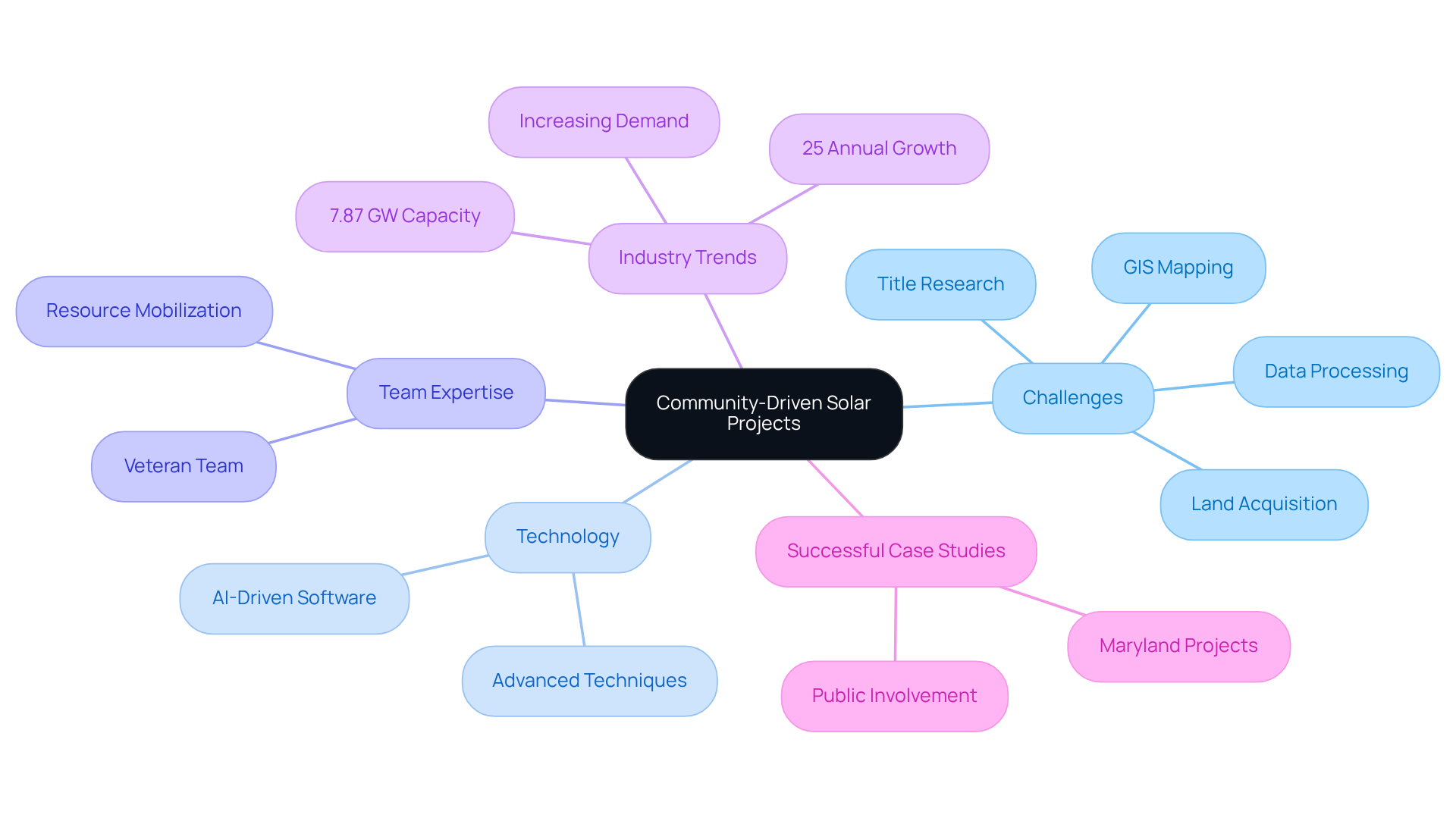
Engage Stakeholders: Foster Community Involvement and Support
Involving stakeholders is paramount for fostering public participation and support in renewable energy initiatives. This can be effectively achieved through:
- Regular meetings
- Surveys
- Open forums that empower members of the public to express their opinions and concerns
By actively engaging local inhabitants, enterprises, and community groups, developers can cultivate trust and ensure that the initiative aligns with the values and needs of the area. Implementing effective communication strategies, such as newsletters and social media updates, keeps stakeholders informed and engaged throughout the project lifecycle.
Effective engagement strategies include:
- Forming advisory groups that reflect diverse local interests
- Organizing informational workshops to enhance understanding of the benefits of renewable energy
According to recent forecasts, substantial increases in solar and wind power generation are anticipated by 2025, underscoring the necessity of stakeholder involvement in these initiatives. Furthermore, as Ralph Nader pointed out, the oil sector does not possess the sun, emphasizing the potential of solar energy to empower communities.
These methods not only enhance stakeholder involvement but also significantly influence the overall success of community-driven solar projects.
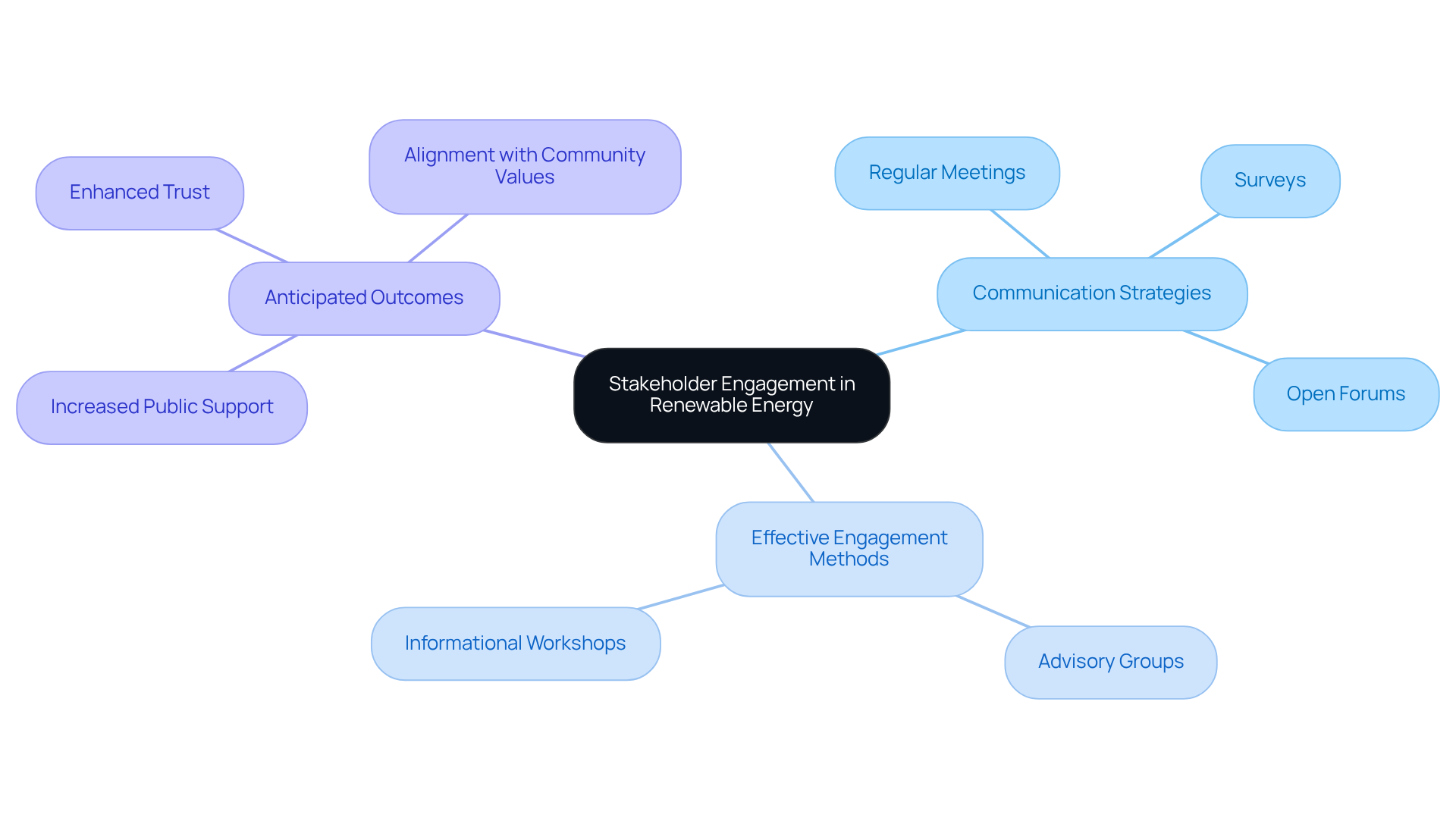
Conduct Site Assessments: Identify Optimal Locations for Solar Installations
Comprehensive site evaluations are crucial for identifying optimal locations for energy installations. This process involves assessing critical factors such as:
- Sunlight exposure
- Land topography
- Proximity to existing infrastructure
By leveraging GIS mapping technology, stakeholders can significantly enhance their assessments through detailed spatial analyses and visualizations. Furthermore, a thorough understanding of local zoning regulations and environmental considerations is vital to ensure compliance and mitigate potential conflicts. A meticulously conducted site evaluation not only lays the groundwork for a successful energy initiative but also addresses the complexities of land acquisition, including legal and regulatory challenges, ultimately leading to effective solutions.
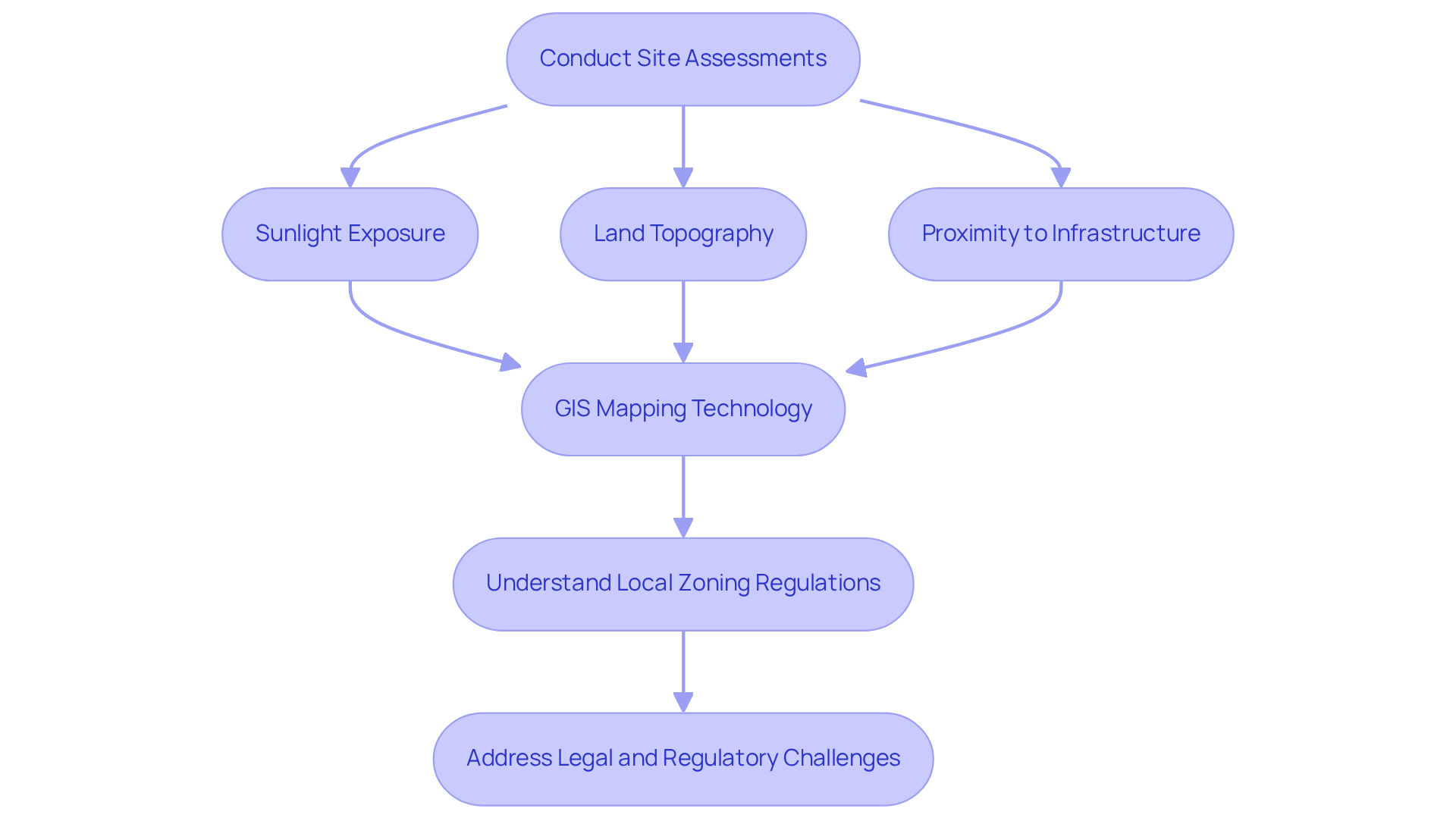
Navigate Legal Requirements: Ensure Compliance with Local Regulations
Understanding legal requirements is critical for community-driven solar projects. Developers must have a comprehensive grasp of local zoning laws, permitting processes, and environmental regulations. By involving legal specialists early in the project, potential obstacles can be identified, and compliance efforts can be optimized. Harbinger Land excels in site and right-of-way acquisitions, employing advanced GIS modeling services to negotiate and secure the necessary leases and easements for distributed energy resource (DER) and infrastructure development. This method not only saves clients time and money but also improves decision-making regarding land rights acquisition.
Establishing open communication with local authorities is essential for facilitating smoother approvals and nurturing positive relationships that can benefit the project in the long run. Effective compliance strategies often include:
- Regular consultations with legal advisors
- The use of technology to monitor regulatory changes
As the landscape evolves, it is vital to remain informed about local regulations and adapt to new legal requirements to ensure the timely execution of the initiative. Developers must pay close attention to updated local zoning regulations and permitting requirements to prevent delays that could impact timelines.
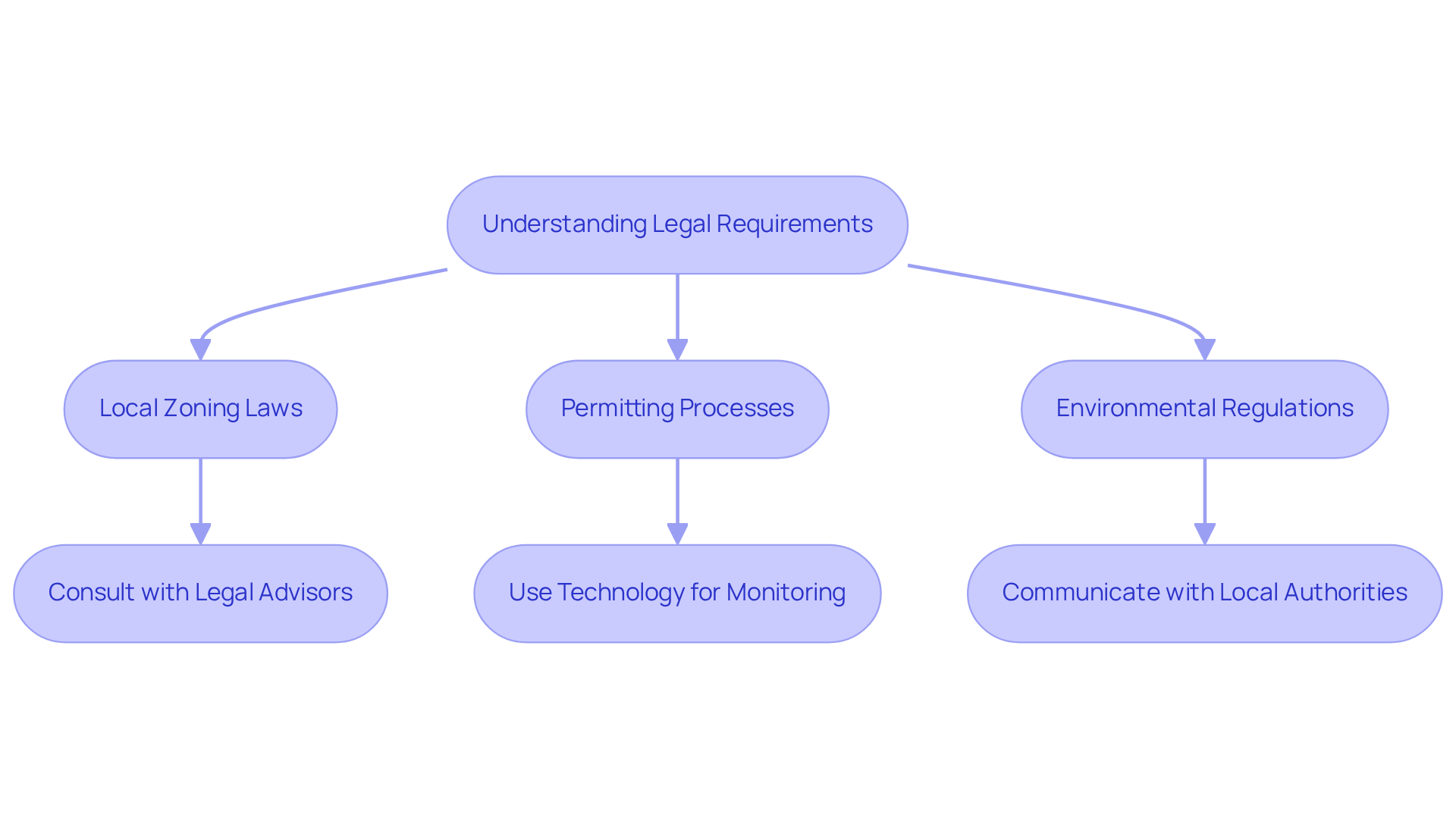
Implement Communication Strategies: Keep the Community Informed
Implementing effective communication strategies is crucial for ensuring that the public remains informed about community-driven solar projects. Regular updates through newsletters, local meetings, and social media not only convey progress but also address concerns and celebrate milestones. Clear communication fosters trust, encouraging individuals to engage actively in the initiative.
Furthermore, providing educational materials on the benefits of solar power enhances public understanding and support for community-driven solar projects, illustrating that informed communities are more likely to embrace such renewable initiatives. Effective strategies for community-driven solar projects require tailored communication that resonates with local values and ongoing dialogue to ensure that community perspectives are recognized and integrated throughout the project lifecycle.
As Dr. Paul Leu emphasizes, 'The surge in solar energy’s popularity is driven by a combination of decreasing costs, increasing awareness of environmental issues, attractive government incentives, and the appealing prospect of energy independence.' This highlights the importance of keeping communities informed about financial incentives, such as the federal tax credit for renewable energy systems, which can recover 30% of the installation cost if installed before 2032.
Additionally, addressing challenges faced by property owners, such as payback periods and local regulations, can further bolster support for renewable initiatives.
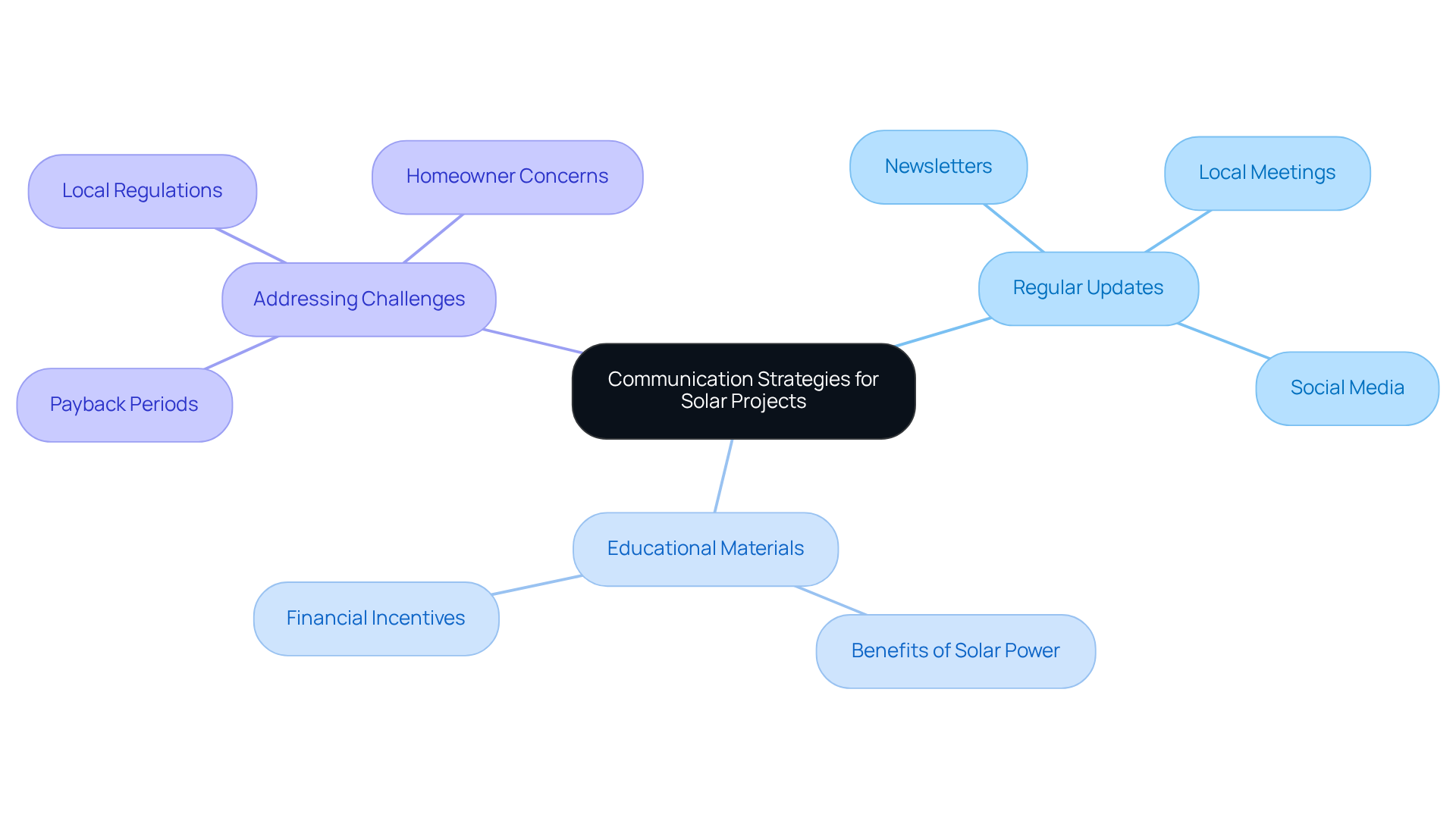
Secure Funding: Explore Financial Options for Solar Projects
Securing funding for community-driven solar projects is essential for successful development, not just beneficial. Developers must explore a variety of financial options, including:
- Government grants
- Tax incentives
- Private investments
For instance, the MI Solar Communities-MI Solar Access Program allocates a minimum of $320,000 in grants to assist areas in overcoming obstacles to clean energy access, with individual awards ranging from $80,000 to $100,000. Notably, statistics reveal that 85% to 100% of granted funding is required to be designated for households with incomes at or below 200% of the federal poverty line, ensuring that underprivileged populations receive vital benefits from these initiatives.
Community-driven solar projects and crowdfunding models present effective avenues for engaging local residents, fostering community support and ownership. However, these models may encounter challenges, such as:
- Difficulties in meeting funding targets
- Navigating regulatory hurdles
Understanding the financial landscape, which includes the implications of the federal Investment Tax Credit (ITC) and state-level incentives, along with potential obstacles like high initial costs and regulatory uncertainty, can significantly enhance a venture's viability and sustainability.
By integrating various funding strategies, developers can create robust financial frameworks that underpin the long-term success of renewable energy initiatives.
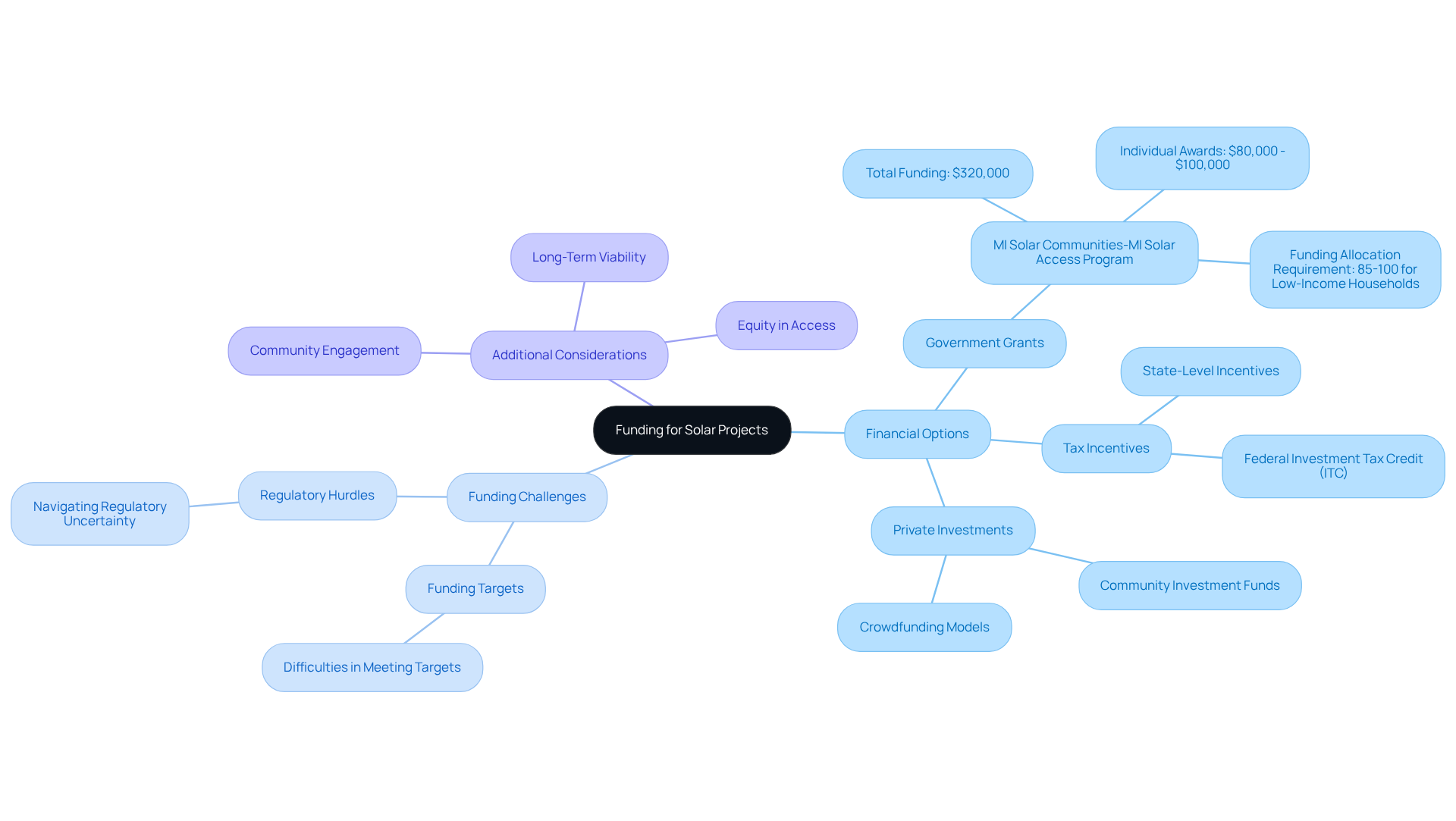
Leverage Technology: Utilize Advanced Tools for Project Efficiency
Harnessing advanced technology is essential for enhancing the efficiency of community-driven solar projects. Tools such as GIS mapping and AI-driven software facilitate efficient site evaluations, improve resource distribution, and enhance management.
For instance, GIS technology empowers developers to visualize geographical data, ensuring optimal site selection and minimizing environmental impact. AI tools can analyze extensive datasets to forecast performance, enabling proactive adjustments that enhance efficiency.
Statistics indicate that initiatives employing these technologies can reduce expenses by as much as 20% and significantly improve timelines. Furthermore, case studies reveal that community-driven solar projects that utilize AI and GIS have experienced a 30% increase in operational efficiency.
As Ken Salazar emphasized, investing in photovoltaic power is vital for achieving autonomy in power sources and reducing pollution. By adopting these innovative technologies, developers can not only mitigate risks but also achieve superior results, ultimately contributing to the advancement of sustainable energy solutions.
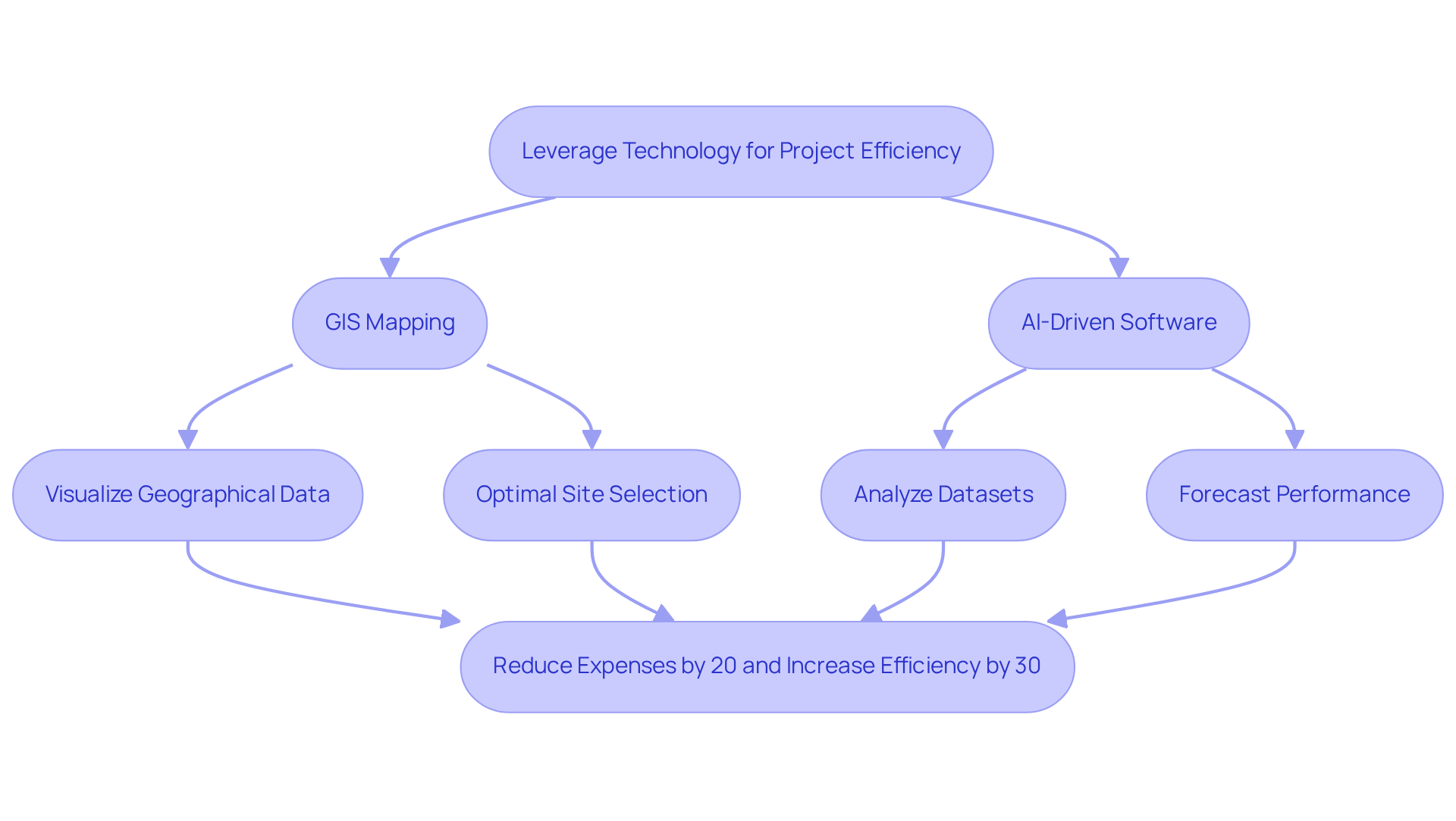
Build Partnerships: Collaborate with Local Organizations and Businesses
Collaborations with local organizations and businesses are vital for the success of community-driven solar projects. By partnering with local associations, environmental groups, and regional businesses, community-driven solar projects enhance visibility, attracting essential support. These alliances facilitate resource sharing—encompassing funding, expertise, and volunteer efforts—which are crucial for the effective execution of community-driven solar projects.
Consider the Middlegrunden Wind Farm in Denmark and the Hvide Sande Wind Farm; both exemplify effective local ownership and cooperation in renewable energy. These cases demonstrate how regional partnerships can lead to substantial success. Additionally, community-driven solar projects in areas such as New York and Illinois demonstrate that regional partnerships significantly improve project outcomes. Notably, Illinois recently announced its largest local energy quarter since Q2 2021, adding 54 MW in Q3 2024.
Statistics underscore this trend: shared energy installations grew by 12% year-over-year in Q3 2024, emphasizing the rising significance of these initiatives. Moreover, approximately 24 states have enacted laws promoting local renewable energy, with 20 of those focusing on low-income involvement. This highlights the critical role of inclusiveness in collaborations.
By fostering a cooperative atmosphere, developers can cultivate a sense of collective ownership and shared responsibility for renewable initiatives. This approach ultimately leads to enhanced long-term success.
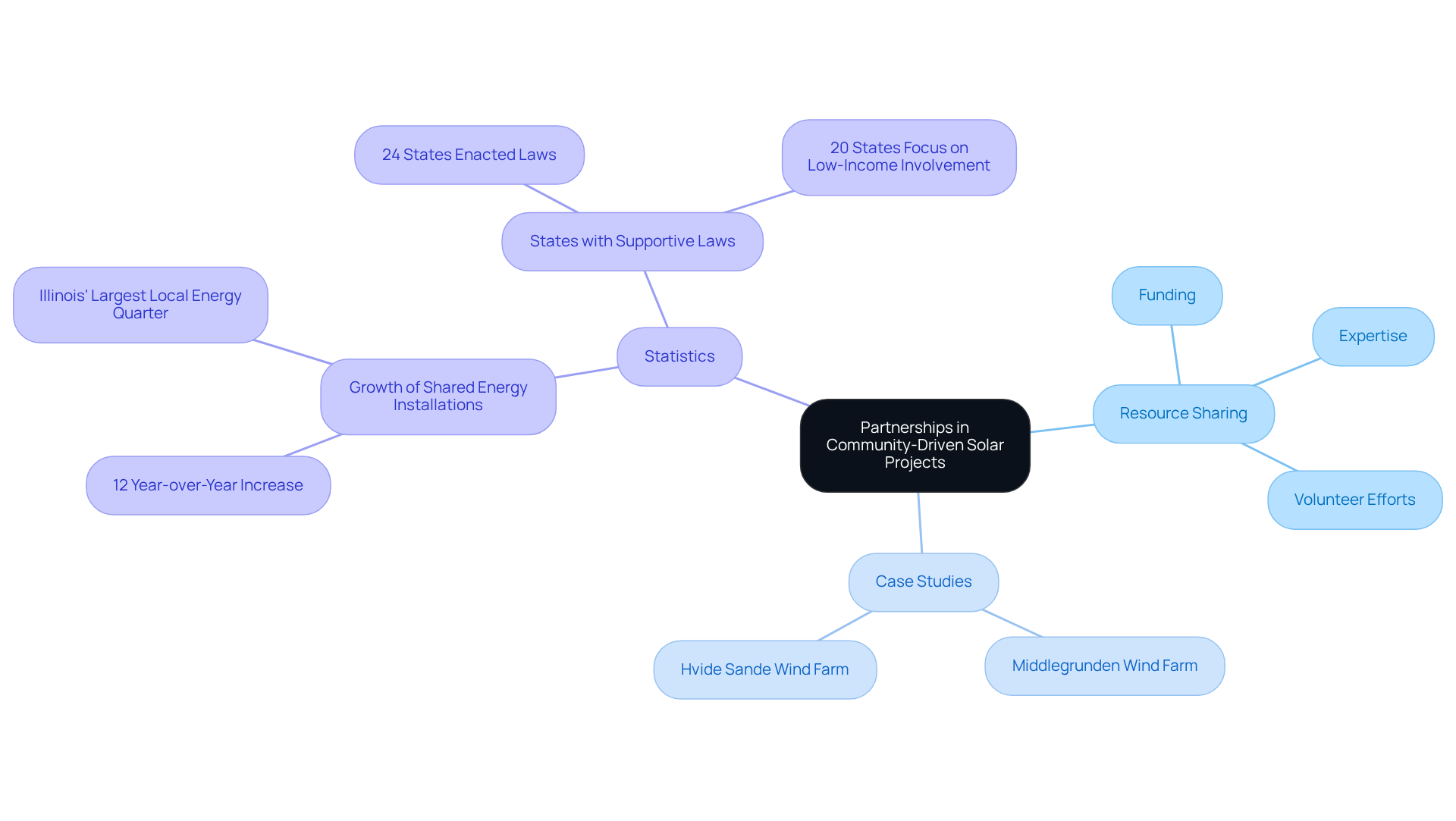
Monitor and Evaluate: Assess Project Impact and Community Satisfaction
Supervising and assessing the effects of community-driven solar projects is essential for ensuring they align with local needs and expectations. Regular assessments not only highlight successes but also identify areas for improvement, enabling developers to make necessary adjustments.
How can we enhance public satisfaction and foster a sense of ownership? By actively engaging the community in the evaluation process, employing surveys, feedback sessions, and performance metrics, we can gain valuable insights into the project's effectiveness and its broader societal impact.
As Greta Thunberg asserts, 'You are never too small to make a difference,' emphasizing the importance of collective participation in these initiatives. Statistics reveal a growing embrace of renewable energy across the U.S., with an increasing number of communities recognizing its benefits.
This collaborative approach ensures that community-driven solar projects are not only technically sound but also resonate with the individuals they serve, ultimately leading to more successful and sustainable outcomes.
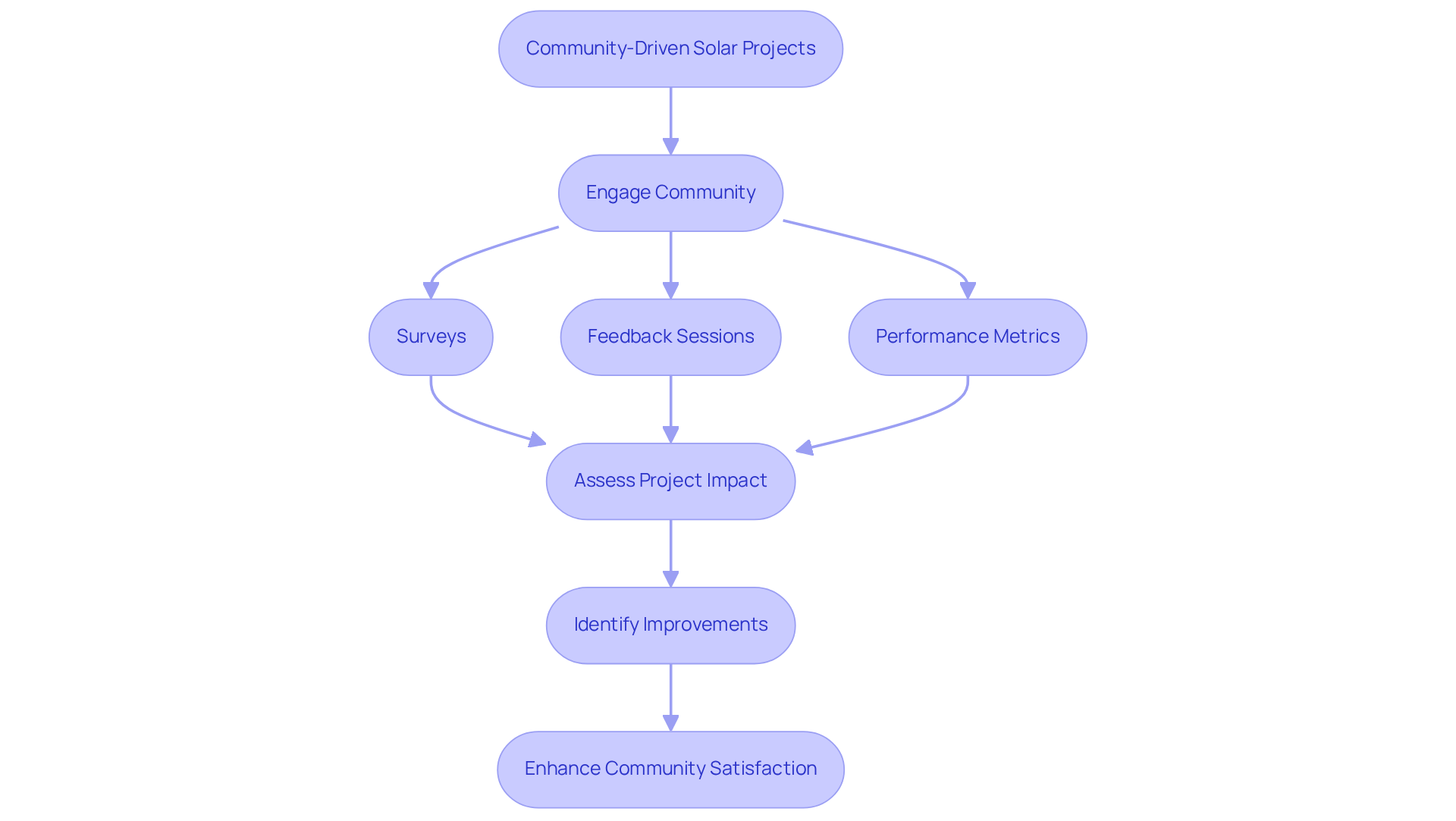
Celebrate Successes: Acknowledge Milestones to Foster Community Pride
Honoring achievements and milestones is essential for community-driven solar projects that focus on energy initiatives. Recognizing accomplishments through local events, press releases, and social media fosters pride and excitement among residents.
For instance, when EDP Renewables launched a 210-MW photovoltaic project in Mississippi, the community celebrated not only the project's completion but also the job opportunities it created, thereby strengthening local support for community-driven solar projects. These celebrations acknowledge the contributions of all involved and highlight the tangible benefits of community-driven solar projects, including job creation and environmental improvements.
Statistics show that groups engaged in community-driven solar projects experience a 25% increase in local pride and participation in sustainability efforts. Furthermore, the renewable energy sector in the U.S. has seen a remarkable 25% annual growth, emphasizing the increasing engagement in community-driven solar projects as part of sustainable initiatives.
By incorporating insights from influential figures like Ramez Naam, who advocates for the transformative potential of renewable energy, developers can bolster local support for community-driven solar projects and encourage future participation in these projects.
To maximize impact, developers should consider organizing regular community events to celebrate milestones, thus creating a cycle of engagement and pride that benefits all stakeholders.
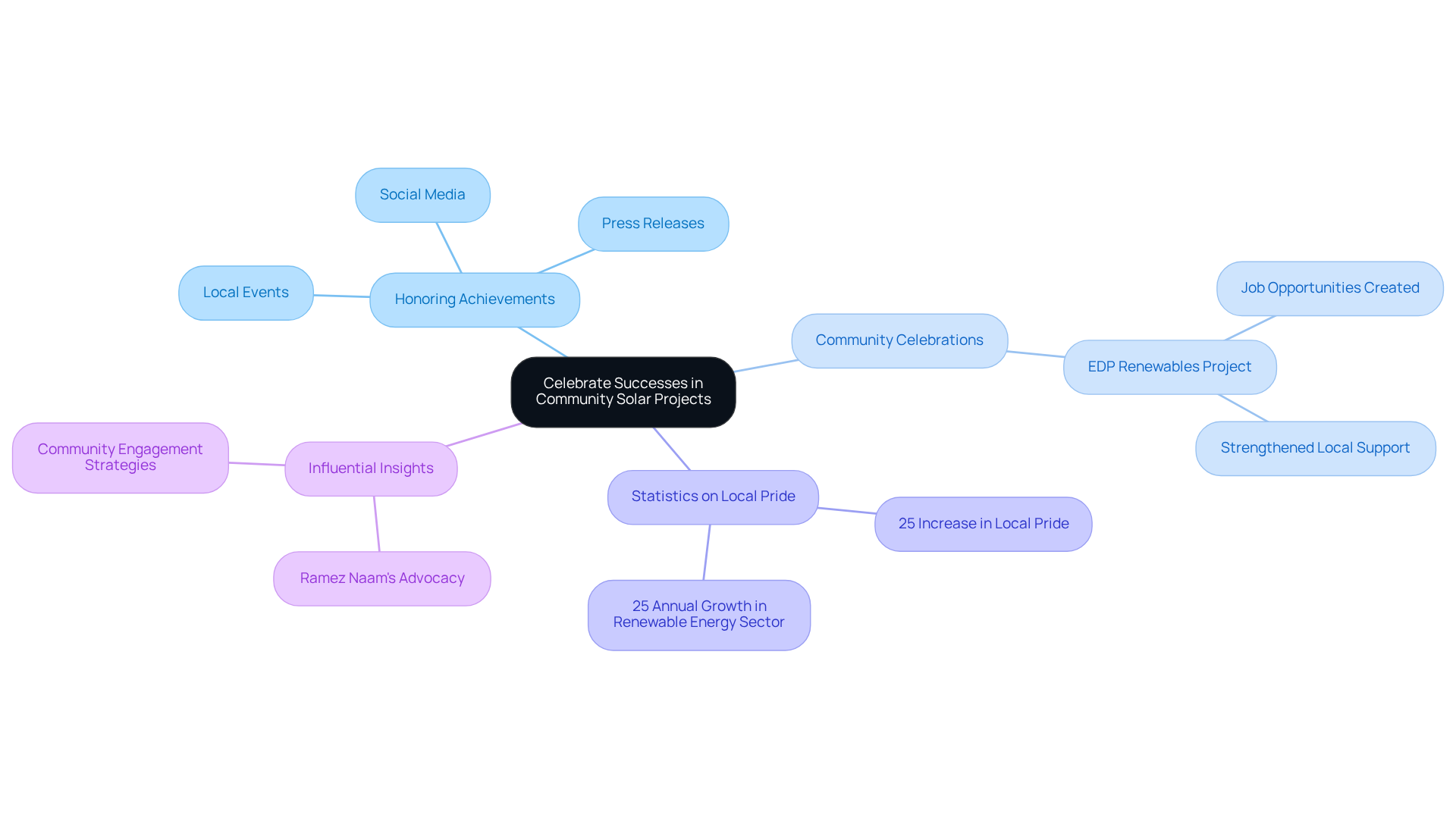
Conclusion
Community-driven solar projects represent a transformative approach to renewable energy, empowering local populations to take charge of their energy future. By emphasizing collaboration, stakeholder engagement, and innovative technologies, these initiatives not only foster environmental sustainability but also enhance community pride and participation.
The article outlines essential steps for successfully implementing community-driven solar projects, including:
- Effective stakeholder engagement
- Thorough site assessments
- Compliance with legal requirements
- Leveraging advanced technology
Each of these components plays a critical role in ensuring that projects are not only feasible but also align with the needs and values of the communities they serve. Additionally, securing funding and building partnerships are vital strategies that enhance project viability and foster a sense of shared ownership.
Ultimately, the success of community-driven solar projects hinges on the collective efforts of all stakeholders involved. By celebrating milestones and acknowledging the contributions of community members, developers can cultivate a culture of pride and ongoing engagement. As the renewable energy landscape evolves, embracing these practices will not only drive the growth of sustainable energy solutions but also empower communities to thrive in a cleaner, more resilient future.
Frequently Asked Questions
What services does Harbinger Land provide for community-driven solar projects?
Harbinger Land offers customized solutions for land acquisition, including site and right-of-way acquisition, title research, GIS mapping, and data processing to support community-driven solar initiatives.
How does Harbinger Land enhance efficiency in solar project implementation?
The company employs advanced technology, such as AI-driven title research software, to improve efficiency and client satisfaction, ensuring smooth implementation of collective energy initiatives.
What is the current trend in community-driven solar projects in the U.S.?
There is an increasing demand for community-driven solar projects, with approximately 7.87 gigawatts of capacity currently in operation in the U.S., reflecting a remarkable 25% annual growth in the renewable energy sector.
How does stakeholder involvement impact renewable energy initiatives?
Involving stakeholders fosters public participation and support, cultivates trust, and ensures that initiatives align with community values and needs, significantly influencing the overall success of solar projects.
What strategies can be used to engage stakeholders effectively?
Effective strategies include regular meetings, surveys, open forums, forming advisory groups, and organizing informational workshops to enhance understanding of renewable energy benefits.
What factors are assessed during site evaluations for solar installations?
Critical factors include sunlight exposure, land topography, and proximity to existing infrastructure, which are essential for identifying optimal locations for energy installations.
How does GIS mapping technology assist in site assessments?
GIS mapping technology enhances site assessments through detailed spatial analyses and visualizations, aiding stakeholders in making informed decisions.
Why is understanding local zoning regulations important in solar project development?
A thorough understanding of local zoning regulations and environmental considerations is vital to ensure compliance and mitigate potential conflicts during the development of solar projects.
List of Sources
- Harbinger Land | Comprehensive Solutions for Community-Driven Solar Projects
- 20 Quotes To Get You Inspired For a Renewable Future - Solstice (https://solstice.us/solstice-blog/20-quotes-for-a-renewable-future)
- Quotes About Solar Power: 50 Picks to Light Up Your Life - Lumify Energy (https://lumifyenergy.com/blog/quotes-about-solar-power)
- Top 10 Inspiring Quotes About Solar Energy - Solar academy (https://solar-academy.com/top-10-inspiring-quotes-about-solar-energy)
- Nearly 100 acres of agriculture land slated for community solar development in Maryland (https://techxplore.com/news/2025-01-acres-agriculture-slated-community-solar.html)
- Community Solar Market Trends (https://energy.gov/communitysolar/community-solar-market-trends)
- Engage Stakeholders: Foster Community Involvement and Support
- 100+ inspirational and powerful quotes on Sustainability (clustered by topic) - Twenty Now (https://twentynow.com/sustainability-initiatives/sustainability/100-inspirational-and-powerful-quotes-on-sustainability-clustered-by-topic)
- 60 Quotes About the Future of Renewable Energy (https://deliberatedirections.com/renewable-energy-quotes)
- Top 10 Inspiring Quotes About Solar Energy - Solar academy (https://solar-academy.com/top-10-inspiring-quotes-about-solar-energy)
- Quotes About Solar Power: 50 Picks to Light Up Your Life - Lumify Energy (https://lumifyenergy.com/blog/quotes-about-solar-power)
- Top Ten Quotes about Solar Power (https://harnessoursun.com/top-ten-quotes-about-solar-power)
- Conduct Site Assessments: Identify Optimal Locations for Solar Installations
- Know Built-Up And Slope Detection For Solar | Genesis Ray (https://genesisray.ai/case_studies/built-up-area-assessment-and-slope-detection-with-machine-learning-and-gis)
- Drone solar land survey data prevents construction errors on flooded Illinois soil | Wingtra (https://wingtra.com/case_studies/drone-solar-land-survey?srsltid=AfmBOool8kzFd2oqVQp-NmY1ytqxs7z3vArRK8gla_-xZhLKrc_yJLJU)
- GIS-Based Solar Radiation Mapping, Site Evaluation, and Potential Assessment: A Review (https://mdpi.com/2076-3417/9/9/1960)
- Navigate Legal Requirements: Ensure Compliance with Local Regulations
- Maryland Governor Wes Moore Enacts Key Environmental and Energy Legislation in Spring 2025 Session, Including EPR for Packaging and Solar Permitting Reforms (https://bdlaw.com/publications/maryland-governor-wes-moore-enacts-key-environmental-and-energy-legislation-in-spring-2025-session-including-epr-for-packaging-and-solar-permitting-reforms)
- Top Solar Quotes (https://inventionsolar.com/solar-quotes)
- Key Compliance Statistics & Insights For 2025 | Zluri (https://zluri.com/blog/key-compliance-statistics-and-insights-for-2024)
- 110 Compliance Statistics to Know for 2025 (https://secureframe.com/blog/compliance-statistics)
- Implement Communication Strategies: Keep the Community Informed
- Top Solar Energy Facts and Statistics (2024) (https://thisoldhouse.com/solar-alternative-energy/reviews/solar-energy-statistics)
- Secure Funding: Explore Financial Options for Solar Projects
- What Are Community Solar Project Financing Options? – Energy → Sustainability Directory (https://energy.sustainability-directory.com/question/what-are-community-solar-project-financing-options)
- Solar for All | US EPA (https://epa.gov/greenhouse-gas-reduction-fund/solar-all)
- EGLE announces $320,000 grant opportunity for community solar projects (https://michigan.gov/egle/newsroom/press-releases/2024/04/10/grant-opportunity-for-community-solar)
- Leverage Technology: Utilize Advanced Tools for Project Efficiency
- Solar Market Insight Report Q4 2024 – SEIA (https://seia.org/research-resources/solar-market-insight-report-q4-2024)
- Solar Industry Research Data – SEIA (https://seia.org/research-resources/solar-industry-research-data)
- 90+ Solar Energy Statistics: The Green Gold Rush (2025) - Enkonn Solar (https://enkonnsolar.com/solar-energy-statistics)
- Quotes About Solar Power: 50 Picks to Light Up Your Life - Lumify Energy (https://lumifyenergy.com/blog/quotes-about-solar-power)
- Top Solar Quotes (https://inventionsolar.com/solar-quotes)
- Build Partnerships: Collaborate with Local Organizations and Businesses
- Community Solar Market Trends (https://energy.gov/communitysolar/community-solar-market-trends)
- (PDF) Cultures of Community Energy: International Case Studies (https://researchgate.net/publication/303684332_Cultures_of_Community_Energy_International_Case_Studies)
- Solar Market Insight Report Q4 2024 – SEIA (https://seia.org/research-resources/solar-market-insight-report-q4-2024)
- Monitor and Evaluate: Assess Project Impact and Community Satisfaction
- Quotes About Solar Power: 50 Picks to Light Up Your Life - Lumify Energy (https://lumifyenergy.com/blog/quotes-about-solar-power)
- 60 Quotes About the Future of Renewable Energy (https://deliberatedirections.com/renewable-energy-quotes)
- 20 Quotes To Get You Inspired For a Renewable Future - Solstice (https://solstice.us/solstice-blog/20-quotes-for-a-renewable-future)
- Top Ten Quotes about Solar Power (https://harnessoursun.com/top-ten-quotes-about-solar-power)
- Celebrate Successes: Acknowledge Milestones to Foster Community Pride
- 100+ inspirational and powerful quotes on Sustainability (clustered by topic) - Twenty Now (https://twentynow.com/sustainability-initiatives/sustainability/100-inspirational-and-powerful-quotes-on-sustainability-clustered-by-topic)
- The Power of Community Quotes (https://ellevatenetwork.com/articles/8538-quotes-about-the-power-of-community)
- 15 Inspirational Quotes for Earth Day (or Any Day) – The Corps Network (https://corpsnetwork.org/15-inspirational-quotes-for-earth-day-or-any-day)
- 20 Quotes To Get You Inspired For a Renewable Future - Solstice (https://solstice.us/solstice-blog/20-quotes-for-a-renewable-future)
- Top 10 Inspiring Quotes About Solar Energy - Solar academy (https://solar-academy.com/top-10-inspiring-quotes-about-solar-energy)




